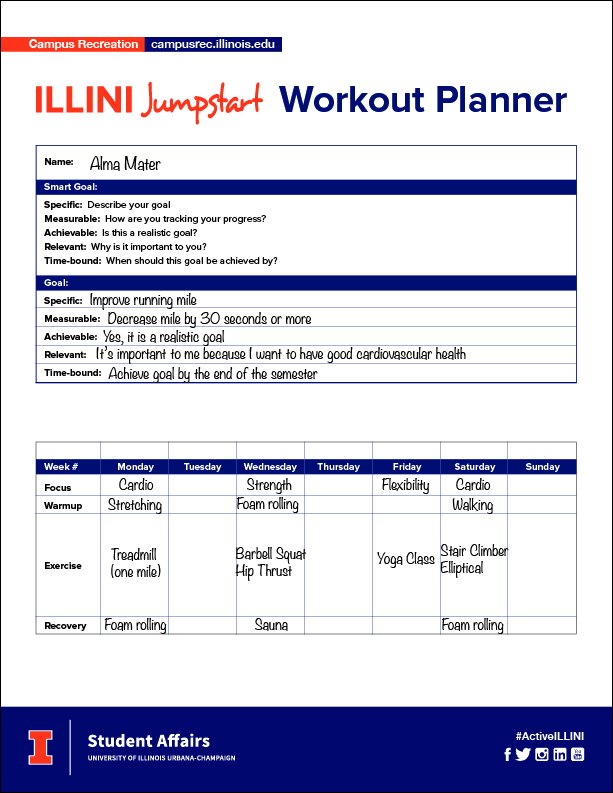
Jumpstart Your Fitness Journey!
Illini Jumpstart is a program designed to give patrons of all fitness levels the knowledge and tools to confidently embark on their fitness journeys. The foundation of this program is creating SMART goals. Once you’ve set goals, you will be able to fill out a workout plan and utilize a series of tutorial videos to help you exercise in a safe and informed way. The goal is to provide you with the tools that will equip you at the start your fitness journey.
Video Tutorials
Warmup & Cooldown
Additional warm-ups include walking/jogging, foam rolling, dynamic stretching, and cycling.
Cardio
Additional cardio workouts include walking, swimming, row machine, cycling, alternate trainers, ellipticals, and dancing.
Core
HIIT
Intensity
Intensity training can include HIIT (high intensity interval training), Tabata, plyometrics, and SAQ (speed, agility and quickness).
Strength
Strength exercises should include all the major muscle groups in the lower body (glutes, quads, hamstrings and calves) and upper body (back, chest, core, biceps, triceps and shoulders). You can find machines for all muscle groups in our facilities. Other strength exercises can include bodyweight, free weights and resistance bands.
Flexibility
Additional flexibility workouts include yoga, pilates, dynamic/static stretching, and foam rolling.
SMART Goals
S: Specific
When setting a goal, be specific about what you want to accomplish. This isn’t a detailed list of how you’re going to meet a goal, but it should include answers to what you want to accomplish and why you’ve chose this goal.
M: Measurable
Using metrics makes a goal more tangible because it provides a way to measure progress. Measurement methods can be both quantitative (how much weight you can lift, how long you run, etc.) and qualitative (how much energy you have, your daily mood, etc.).
A: Achievable
Focus on how important this goal is to you and what you can do to make it attainable. This may require developing new skills and/or changing your attitude. Strike a balance between challenging yourself, but being realistic with the outcome. Think about if you have the necessary tools/skills.
R: Relevant
Relevance refers focusing on something that makes sense in the context of your daily habits and overall lifestyle. Making a goal relevant inspires action and will motivate you to achieve it. Consider whether this is the right time for this goal and what specific steps you need to get there.
T: Time-Bound
Set a target date for you to achieve your goal. If your goal will take three months to complete, it’s useful to define what should be achieved half-way through the process. Providing time constraints also creates a sense of urgency.
Workout Planner
